|
For more than half a century, Roy was involved in
a wide variety of social movements and progressive organisations. Although
over the decades most of the groups that he worked with were engaged in raising
public awareness about issues of war and peace, as well as related humanitarian
and civil-rights issues. Among the influences leading Roy into his support
for these activist causes were the
poverty he experienced as a
child and his experiences
in India during WWII. The biggest influence was his
61-year marriage to Sylvia,
who often took the lead in their participation in the peace movement, especially
during the years when he worked at NRC. Roy's
work in the field of physics
also influenced his work in the peace movement and should not be overlooked.
The approach and focus of Roy's involvement in
peace issues during the Cold War was influenced by his career as a physicist.
For one thing, many of the peace organisations that Roy and Sylvia were active
in focused much attention on atomic weapons, the threat of nuclear war and the
dangers of radiation. As a professional physicist, he was directly engaged
in the scientific study of radiation and was knowledgeable about its powerful
dangers. Also important to note is that his physics career allowed him to
travel to conferences in the USSR and other socialist countries. The
friendly work relations that he enjoyed with people from these so-called "enemy"
nations, afforded him a special insight which influenced his peace activism
during the height of the Cold War when so many around him were struck by an
irrational social phobia and hatred of all things Soviet.
Here is a chronological summary of the main organisations, movements and
peace-related campaigns in which Roy and Sylvia were involved.
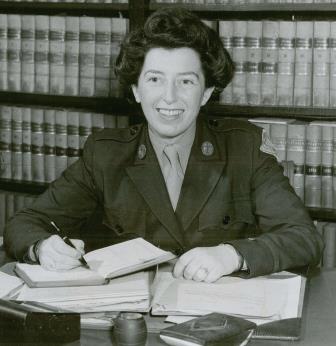
Unitarian Service
Committee (USC)
One of the first progressive organisations that Sylvia and Roy became active
with was the USC. They began volunteering for USC Canada in 1953. At that time,
Lotta Hitschmanova
(photo at right)
was running the USC out of the basement
of the Unitarian Church at the corner of Elgin and Lewis Streets in Ottawa's downtown core. The organisation was
then focused on providing food, educational supplies, clothing, housing and money
to help refugees in Europe whose lives had been thrown into chaos by World War
II. Roy and
Sylvia initially got involved in the USC by donating clothing and by joining
other volunteers in packing bales of clothes for shipment to war-torn refugees
in Europe. It was
through this involvement with the USC that Roy and Sylvia first learned about
Unitarianism and started to attend its Ottawa church.
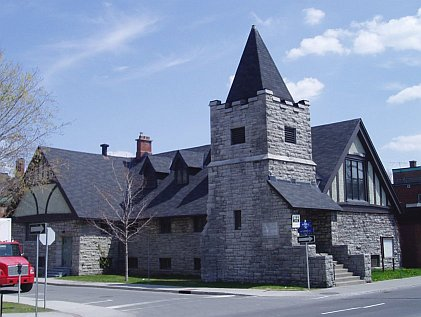 First Unitarian
Congregation of Ottawa First Unitarian
Congregation of Ottawa
Sylvia and Roy started going to Unitarian services before leaving for Britain in
1953, where Roy worked on his Ph.D in Physics.
At that time, the Unitarian church was still located downtown (See image at
left). This first Unitarian church was built in 1900. Unitarians
however had been meeting in Ottawa since 1877. That is when they formed the "Progressive Society of
Ottawa" which they said "learnedly discussed theological, humanitarian and
philosophical subjects."
Soon after Roy and Sylvia returned to Ottawa
from Britain in late 1955, they became members of this Unitarian congregation. Sylvia
even taught Sunday school classes. While teens were thoughtfully introduced to a
wide variety of different religious traditions, all teachings about God were strictly avoided
in church classes for the younger children. Because children were seen as being
so susceptible to religious indoctrination, Ottawa Unitarians thought young
people should be allowed to choose their beliefs for themselves when they were
old enough to be good, critical thinkers. This appealed to Roy
and Sylvia because they were both ardent atheists.
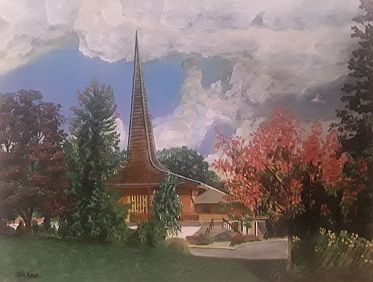 Sylvia was on the Congregation's
Board of Directors in 1967 when the Church decided to move to their current location on Cleary Avenue in Ottawa's west end. Along with
friend and fellow peace and civil rights activist, Nick Aplin, Roy was elected to the
congregation's Board in 1970.
Roy and Sylvia's involvement with the congregation often involved trying to move its
members and ministers to become more actively involved in protesting war and
promoting peace issues. This was especially difficult at times, such as during
the Vietnam War, when a Minister of the Church, an American, had great difficulty
bringing himself to criticise the US government. (Nick
alluded to this during Roy's Memorial Service when recounting memories
of their sometimes difficult efforts to work within the Unitarian Church.) Sylvia was on the Congregation's
Board of Directors in 1967 when the Church decided to move to their current location on Cleary Avenue in Ottawa's west end. Along with
friend and fellow peace and civil rights activist, Nick Aplin, Roy was elected to the
congregation's Board in 1970.
Roy and Sylvia's involvement with the congregation often involved trying to move its
members and ministers to become more actively involved in protesting war and
promoting peace issues. This was especially difficult at times, such as during
the Vietnam War, when a Minister of the Church, an American, had great difficulty
bringing himself to criticise the US government. (Nick
alluded to this during Roy's Memorial Service when recounting memories
of their sometimes difficult efforts to work within the Unitarian Church.)
Committee Against Radiation
Hazards (CARH)
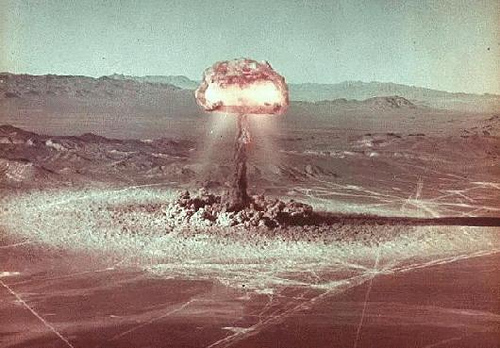 Roy and Sylvia began attending protests and marches held by the CARH in 1959.
The organisation was active in raising much-needed public awareness about the hazards of
nuclear fallout that were being caused by the atmospheric testing of atomic bombs.
In 1957, when Richard was born, the US exploded 34 nuclear bombs yielding 346
kilotons. In the following year they blew up 75 more nuclear bombs. Those
bombs, in 1958 alone, exploded with an energy equivalent to 35,700 kilotons of
TNT. The destruction of Hiroshima used a bomb yielding only 15 kilotons, while
Nagasaki was 20 kilotons. All of the radioactive material from the US nuclear
"testing" program went into the atmosphere and then fell to earth. Since many of
most of these explosions were done in Nevada, and the prevailing winds were
blowing all that radioactive fallout eastward, there were obvious and very
legitimate concerns about environmental damage and negative impacts on people's
health. However, only a small number of people cared or even knew anything
about what was going on. Many still don't even know that the US exploded
so many nuclear bombs within its own borders. (See this list of 29 nuclear
explosions that were part of
"Operation Plumbbob"
at the Nevada test site between May 28 and Oct. 7, 1957. The image above
shows one of the "Plumbbob" explosions in Nevada that took place right around
the time of Richard's birth. (See
a listing of all the US atmospheric nuclear "test" explosions.) Roy and Sylvia began attending protests and marches held by the CARH in 1959.
The organisation was active in raising much-needed public awareness about the hazards of
nuclear fallout that were being caused by the atmospheric testing of atomic bombs.
In 1957, when Richard was born, the US exploded 34 nuclear bombs yielding 346
kilotons. In the following year they blew up 75 more nuclear bombs. Those
bombs, in 1958 alone, exploded with an energy equivalent to 35,700 kilotons of
TNT. The destruction of Hiroshima used a bomb yielding only 15 kilotons, while
Nagasaki was 20 kilotons. All of the radioactive material from the US nuclear
"testing" program went into the atmosphere and then fell to earth. Since many of
most of these explosions were done in Nevada, and the prevailing winds were
blowing all that radioactive fallout eastward, there were obvious and very
legitimate concerns about environmental damage and negative impacts on people's
health. However, only a small number of people cared or even knew anything
about what was going on. Many still don't even know that the US exploded
so many nuclear bombs within its own borders. (See this list of 29 nuclear
explosions that were part of
"Operation Plumbbob"
at the Nevada test site between May 28 and Oct. 7, 1957. The image above
shows one of the "Plumbbob" explosions in Nevada that took place right around
the time of Richard's birth. (See
a listing of all the US atmospheric nuclear "test" explosions.)
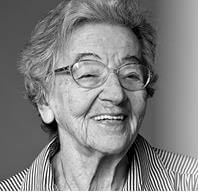 Canadian
Voice of Women
for Peace Canadian
Voice of Women
for Peace
In about 1962, Sylvia joined the Voice of Women
(VOW). Roy and Sylvia -- along with hundreds of others -- sent their
young children's milk teeth to VOW so that they could be tested for radioactive
elements from the fallout of atomic explosions in Nevada. These tests
confirmed the presence of high levels of Strontium-90 in their teeth. It is a
radioactive isotope from nuclear bombs. The tests were done by Dr. Ursula
Franklin (see right), a University of Toronto metallurgist and research
physicist who later became a subscriber and strong supporter of COAT's magazine,
Press for Conversion! In 2016, after receiving another donation from her,
Richard wrote to say thanks and she replied: "I assure you of my deep
appreciation of the unique work that you are doing... Please let me assure
again how deeply I appreciate your work; I can only hope that there will be
younger people to provide some of the assistance and fellowship that is so
needed." She was 95 and died the following year.
In 1987, a "half-life" ago, when Richard was
exactly half the age he is now, he went on a much-needed "holiday" to Los Vegas,
Nevada. Skipping all the casinos he headed straight for the nearby nuclear
weapons testing range where he joined a desert "peace camp." For a week Richard
joined thousands of other protesters who camped there to resist America's
ongoing underground nuclear bomb testing program. He was arrested twice in the
Nevada desert, once with about 1000 others when they all simultaneously climbed
the fence to enter the nuclear test site, and a second time with a smaller group
that was apprehended on the site by forces who descended upon them by
helicopter!
 Canadian
Campaign for Nuclear Disarmament - Ottawa (CCND-Ottawa) Canadian
Campaign for Nuclear Disarmament - Ottawa (CCND-Ottawa)
During the early 1960s,
Sylvia and Roy were involved in the Ottawa chapter of the CCND. This
organisation was on the forefront in actively opposing the atmospheric testing
of nuclear weapons. It also tried, unsuccessfully, to stop the deployment of US nuclear weapons
to Canada. Unfortunately however, as soon as he took power in 1963, the
winner of the 1957 Nobel Peace Prize, Prime
Minister Lester B. Pearson, happily welcomed American nuclear missiles into
Canada. These Bomarc missiles armed with US nuclear warheads were stationed in
BC and Quebec. Prime Minister John Diefenbaker had been strongly opposed to this and was ousted largely
because of his refusal to concede to US demands that Canada base their weapons
here. During their 60 years of peace activism, Roy and Sylvia only ever
met one Canadian Minister of Defence. That was the Diefenbaker
government's Howard Green.
The CCND also had a campaign against
war toys. The CCND poster at left is in Richard's collection of
Sylvia and Roy's peace-related documents. Richard recalls how upset he was at an early age that he
was not allowed to have a toy water pistol. Sylvia explained to him that even just
pretending to shoot people should not be a source of fun. Thirty years
later, in the 1990s, Sylvia, Roy and Richard created a roving "War Toy Recycling
Depot" which they set up at various book stores, churches and pre-schools in Ottawa.
This was one of many projects they worked together on through the
Coalition to Oppose the Arms Trade. (See down
at the bottom of this list.)
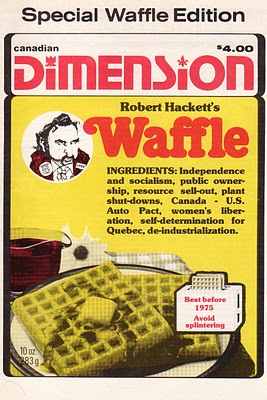 New Democratic Party
- The Waffle Movement New Democratic Party
- The Waffle Movement
Sylvia and Roy were involved in the NDP since its creation in 1961. In the
late 1960s and early 1970s, Sylvia was very active in the Waffle movement and
was a Waffle delegate at the 1969 NDP convention in Winnipeg. Roy was fully
supportive of her efforts with The Waffle which was trying to work within the
NDP to get it to, for instance, endorse policies that opposed imperialism and
war, and were more independent from US foreign policies. The Waffle was formerly
called the
Movement for an Independent Socialist Canada (Click link to read its
manifesto.) Sylvia was a "Waffle delegate" to the NDP convention in Winnipeg in
1969. She remained active in the Waffle until it was expelled from the NDP in
1972. This was a blow to both Sylvia and Roy which led them to pull back
from their very active involvement within the NDP. During elections in the 1970s, Roy took on the task of making lawn signs
in their
garage using the silk-screen process. During various elections Roy and
Sylvia did door-to-door canvassing and Roy coordinated the distribution
of NDP lawn signs throughout the Ottawa riding of Carleton East in some
elections in the 1980s. They did continue to support the NDP throughout their
lives, especially when those on the party's left took more progressive positions
on various peace issues.
World
Federalists
In the early 1960s, Roy and Sylvia were
also briefly engaged with some efforts of the World Federalists in Ottawa.
That was when it used to be involved in producing and
presenting some reports and briefs to the government which opposed war. In
particular, Roy and Sylvia were involved when this group took some steps to
criticise the Vietnam War. Roy
recalled using the Gestetner machine in the World Federalist office to run off
copies of various documents.
Ottawa Committee for Human Rights
(OCHR)
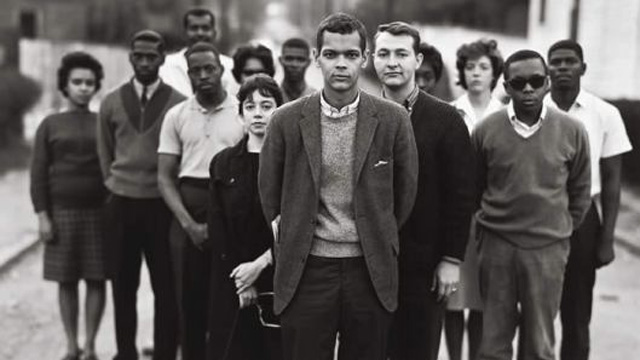 In the
mid-1960s, Sylvia and Roy were active in Ottawa-based solidarity work to support civil rights
activists who were on the front line in nonviolent struggles against the
brutal apartheid system in the U.S. For example, between 1964 and 1966,
Sylvia was deeply involved in helping to bring the Student
Nonviolent Coordinating Committee (SNCC)
Freedom Singers to Ottawa. This included organising fundraising events
which allowed these SNCC representatives to visit Ottawa two or
three times. Sylvia arranged media interviews for these American activists and transported them to
their various appointments, meetings and other activities.
Roy also supported Sylvia in
her efforts to bring Julian Bond to Ottawa.
Bond had helped found SNCC and, as its communications director, edited its
newsletter (Student Voice). (See photo above of Bond with
SNCC Atlanta office staff in
1963.) Learn more about Bond
and SNCC
here and
here. (Gary
Schofield, when speaking at Roy's memorial service, recalled being at the Sanders'
home when Bond showed up.) In 1965, Sylvia and Roy worked with OCHR and the
Student
Union for Peace Action to help organise the largest Ottawa demonstration of its
time. That protest was held when racist police violence
was brought down upon peaceful civil rights marchers in Selma, Alabama.
Roy and Sylvia's friend, Nick
Aplin, remembers calling Sylvia from Toronto to ask her to help arrange
billets in Ottawa for several hundred people who would be protesting there in
two days. She
and an Anglican priest (from All Saints) quickly spread the word through Ottawa's activist community
to accommodate the Torontonians. In the
mid-1960s, Sylvia and Roy were active in Ottawa-based solidarity work to support civil rights
activists who were on the front line in nonviolent struggles against the
brutal apartheid system in the U.S. For example, between 1964 and 1966,
Sylvia was deeply involved in helping to bring the Student
Nonviolent Coordinating Committee (SNCC)
Freedom Singers to Ottawa. This included organising fundraising events
which allowed these SNCC representatives to visit Ottawa two or
three times. Sylvia arranged media interviews for these American activists and transported them to
their various appointments, meetings and other activities.
Roy also supported Sylvia in
her efforts to bring Julian Bond to Ottawa.
Bond had helped found SNCC and, as its communications director, edited its
newsletter (Student Voice). (See photo above of Bond with
SNCC Atlanta office staff in
1963.) Learn more about Bond
and SNCC
here and
here. (Gary
Schofield, when speaking at Roy's memorial service, recalled being at the Sanders'
home when Bond showed up.) In 1965, Sylvia and Roy worked with OCHR and the
Student
Union for Peace Action to help organise the largest Ottawa demonstration of its
time. That protest was held when racist police violence
was brought down upon peaceful civil rights marchers in Selma, Alabama.
Roy and Sylvia's friend, Nick
Aplin, remembers calling Sylvia from Toronto to ask her to help arrange
billets in Ottawa for several hundred people who would be protesting there in
two days. She
and an Anglican priest (from All Saints) quickly spread the word through Ottawa's activist community
to accommodate the Torontonians.
 Ottawa
Committee for Ottawa
Committee for
Medical Aid
to Vietnam Citizens
In the late 1960s, Sylvia played a leading
role in the Ottawa peace movement's opposition to the Vietnam War. Roy was
a stalwart supporter of her efforts, their home was a hub of antiwar activity
and their mailing address was used publicly to funnel medical aid -- at least in
part -- to the Viet Cong. On February 17, 1967, her picture appeared on the
front page of the Ottawa Journal. (See left.) The Journal
article focused on her efforts to raise money through the sale of personal items
donated by such people as Prime Minister Lester Pearson, Olive Diefenbaker (ie
the former PM's wife), NDP MPs Tommy Douglas, Stanley Knowles and David Lewis.
The reporter wanted to know if these people knew they were giving money to the
Viet Cong. Sylvia said yes. Tommy said absolutely, and Olive didn't seem to
know. Sylvia was the main organiser of this auction, held at the former
Unitarian church downtown. It aided civilian victims of the US war and was
funnelled through the Canadian Friends' Service Committee
(Quakers), Red Cross organisations of North and South Vietnam, and the National
Liberation Front (NLF). The NLF was the proper name of the Viet Cong, a mass
political organization in South Vietnam. Besides being antiImperialist and
communist it also had its own army that was fighting against the US military.
The Ottawa Citizen's page 2 article, which did not mention the Viet Cong angle,
reported that the auction raised $790.84. That is the equivalent of
$5,884.39 in 2018 dollars.
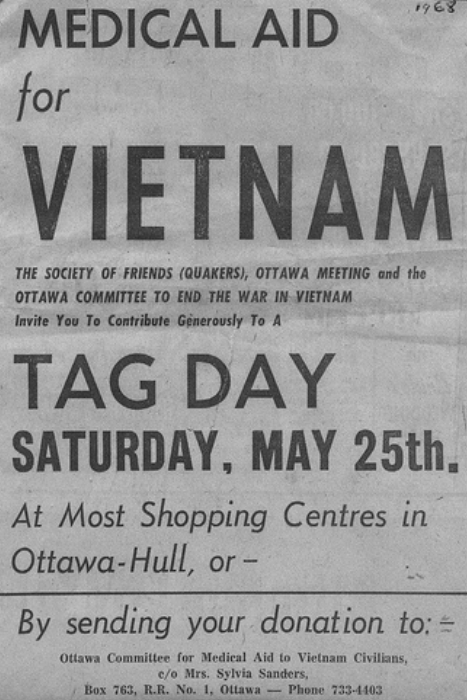 More
than a year later, Sylvia was still was at the centre of these controversial
fundraising efforts. This time Ottawa peace activists were holding a "tag day."
On May 24, 1968, the Ottawa Citizen reported that organisers had 100
volunteers to collect money at 16 Ottawa shopping centres. To announce their
fundraising campaign the Committee took out an ad in the Citizen. (See
image, right). This ad included a list of
about 250 "local citizens" who had "lent their names as public sponsors" of
the appeal. (Read the list of
names here that appeared below the text, at right.) The sponsors
were divided into 11 categories: "Clergy" (30), "Science, Engineering,
Technology" (19); "Community Organisations" (5); "Education" (73); "Wives and
Mothers" (28); "The Arts" (14); "Students" (4); "Labour" (9); "Business
and Management" (9); "Professions" (39); and "Communications (Press, Radio, TV,
other)" (15). This list is a who's who of Ottawa's anti-war movement in
the late 1960s. These were household names in the Sanders' home because
many were Roy and Sylvia's friends and fellow activists. Roy's name was
listed among the sponsors as were some of his colleagues at the
National Research Council. The ad used the Sanders' home phone number and
their address saying "Ottawa Committee for Medical Aid for Vietnam Citizens, c/o
Mrs. Sylvia Sanders." (See image at right)
This committee was created by the Ottawa Society of Friends (Quakers) and the
Ottawa Committee to End the War in Vietnam. More
than a year later, Sylvia was still was at the centre of these controversial
fundraising efforts. This time Ottawa peace activists were holding a "tag day."
On May 24, 1968, the Ottawa Citizen reported that organisers had 100
volunteers to collect money at 16 Ottawa shopping centres. To announce their
fundraising campaign the Committee took out an ad in the Citizen. (See
image, right). This ad included a list of
about 250 "local citizens" who had "lent their names as public sponsors" of
the appeal. (Read the list of
names here that appeared below the text, at right.) The sponsors
were divided into 11 categories: "Clergy" (30), "Science, Engineering,
Technology" (19); "Community Organisations" (5); "Education" (73); "Wives and
Mothers" (28); "The Arts" (14); "Students" (4); "Labour" (9); "Business
and Management" (9); "Professions" (39); and "Communications (Press, Radio, TV,
other)" (15). This list is a who's who of Ottawa's anti-war movement in
the late 1960s. These were household names in the Sanders' home because
many were Roy and Sylvia's friends and fellow activists. Roy's name was
listed among the sponsors as were some of his colleagues at the
National Research Council. The ad used the Sanders' home phone number and
their address saying "Ottawa Committee for Medical Aid for Vietnam Citizens, c/o
Mrs. Sylvia Sanders." (See image at right)
This committee was created by the Ottawa Society of Friends (Quakers) and the
Ottawa Committee to End the War in Vietnam.
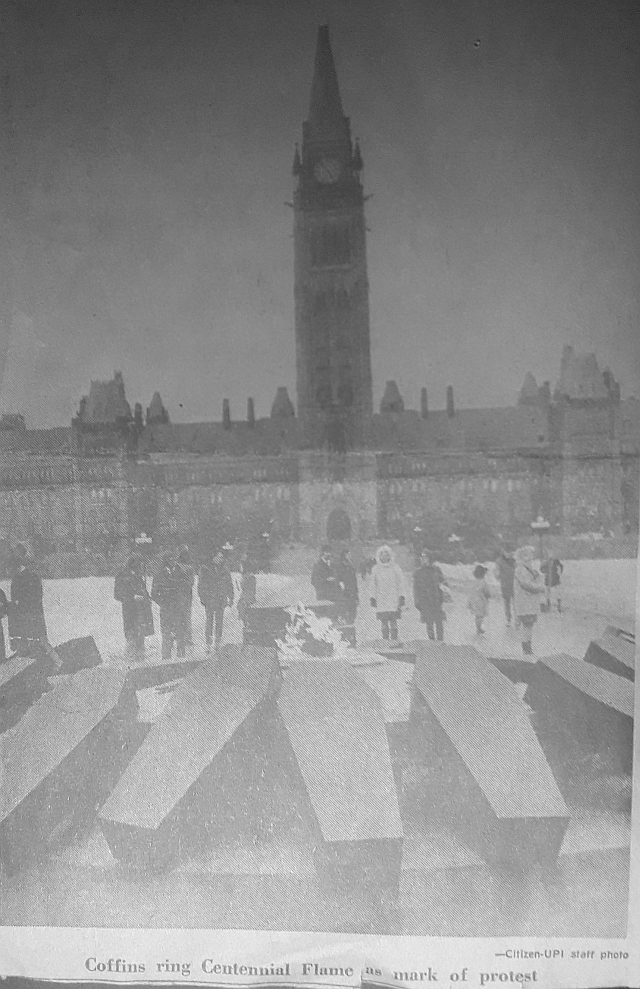 AntiApartheid Protests AntiApartheid Protests
The early 1970s were also a time when Sylvia
and Roy were involved in demonstrations against South Africa's apartheid regime.
Roy as usual was involved as a supporter and volunteer, while Sylvia was
actively engaged in organising protests and other events. Their work focused on
exposing the involvement of Canadian corporations and the Canadian government in
South Africa's racist system. For example, in 1970, there was a protest on Parliament Hill
to commemorate the 10th
anniversary of the March 20, 1960, Sharpeville massacre. South African police
had open fired on Black protesters wounding 180 and killing 69 (including 8
women and 10 children). In Ottawa, a procession of 100 protesters carried 30 black
coffins through the rain, wet snow and rush-hour traffic from Parliament Hill to the South African
Embassy. Activists then placed the coffins around the embassy's walls and
lit candles. This 10th anniversary event was used to tell Canada to sever
diplomatic ties with South Africa and divest from apartheid. (These were
the same demands when Richard was involved in antiApartheid actions about 20
years later.) Roy and Sylvia saved an Ottawa Citizen article (March 21,
1970) which features the photo at left. In it a woman can be seen wearing a white, Inuit-style coat
among the protesters and their coffins. This is likely Sylvia as she wore an
identical coat
in those days. (Read
the Citizen article here.)
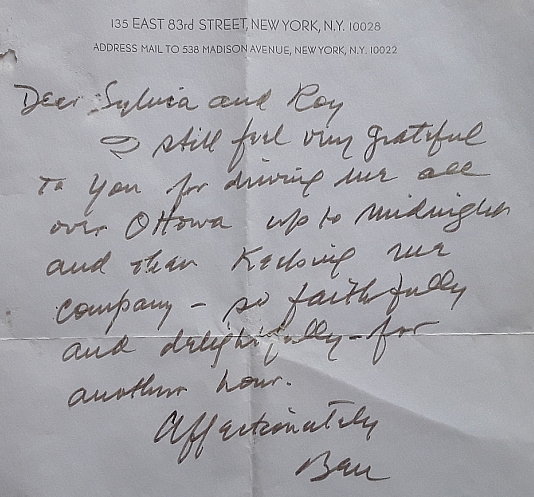 Ottawa Committee for Ottawa Committee for
Peace and Liberation (OCPL)
In the early 1970s, Sylvia and Roy were involved in various OCPL events.
While Sylvia took the lead on this work, Roy as usual was a keen supporter and
volunteer. In December 1970, the OCPL brought
world-famous paediatrician and antiwar activist
Dr. Benjamin Spock
to Ottawa for a
speaking event. This event, entitled "Dissent and Social Change," was
attended by about 350 people at Glebe Collegiate. Issues discussed
included Trudeau's recently passed War Measures Act and the Black Panther's who
Spock said had a right to have weapons to defend themselves against
heavily-armed racists. (Read
the newspaper article about this event.) Roy and Sylvia were responsible for driving
Dr. Spock around Ottawa to various media interviews, meetings and events. In a
handwritten note to Sylvia and Roy, Ben Spock said "I still feel very
grateful to you for driving me all over Ottawa up to midnight and then keeping
me company -- so faithfully and delightfully -- for another hour." Sylvia
was the main organiser of a dinner at First Unitarian Congregation whose purpose was to
allow Ottawa activists from the OCPL to meet with Dr. Spock.
Operation Dismantle, Gloucester
From the late 1970s and to the mid 1980s, Roy and Sylvia were very active in
opposing the Canadian government's Cold War policies. This included NATO
support for the first use of nuclear weapons. As part of their activism, they
became key activists in the Gloucester Committee of a national group called
Operation Dismantle. Through this work they organised numerous events and
campaigns to raise the public awareness and to pressure the government on the
need for
 nuclear
disarmament. They collected names on a petition to pressure the Gloucester City
Council to have a referendum on nuclear disarmament during the November 1982
municipal elections. For this purpose they attended three Gloucester Council
meetings. (In this 1982 photo, Roy wears a toque and light coat, centre left,
while Sylvia holds banner which she made, at right. That's Dorothy Funke in the
Centre.) nuclear
disarmament. They collected names on a petition to pressure the Gloucester City
Council to have a referendum on nuclear disarmament during the November 1982
municipal elections. For this purpose they attended three Gloucester Council
meetings. (In this 1982 photo, Roy wears a toque and light coat, centre left,
while Sylvia holds banner which she made, at right. That's Dorothy Funke in the
Centre.)
Gloucester Peace
Group (GPC)
Roy and Sylvia were instrumental in
forming the Gloucester Peace Group in the early 1980s. Among other things, it
supported Operation Dismantle campaigns. One of the efforts which their local
group engaged in was to raise public awareness about nuclear weapons issues by
pushing city authorities to declare Ottawa a Nuclear Weapons Free Zone. Dorothy
Funke, Blodwyn Piercy, Pam
Mayhew and many other Ottawa-east friends of Roy and Sylvia, were actively
involved in this group which often met at the Sanders' home. The GPC also
collected signatures for the Peace Petition Caravan Campaign which, starting in
BC, brought more than
430,000 signatures, from over 200
communities, to Ottawa. It raised
public awareness by urging the government to declare Canada a Nuclear Weapons
Free Zone.
Educating for Peace (EfP)
Roy was active in getting
this group started in the early 1980s. It focused on providing educational
resources on a variety of peace issues that teachers across Ontario could use.
It was also engaged in lobbying government authorities and Boards of Education
on the curricula that could be used to teach peace issues to students at various
levels. The key activists and organisers within EfP included several
people who were Roy and Sylvia's friends and fellow peace activists. These
activist friends who were central to EfP included Dorothy Funke, Blodwyn Piercy
and Penny Sanger.
Veterans Against Nuclear Arms
(VANA)
Science for Peace
(SfP)
During the 1980s and 1990s, Roy was a member and
supporter of SfP and VANA.
Peace Resource Centre
(PRC)
Sylvia was on the Board of Directors
between 1983 until 1986. Although Roy was not on its board, he was involved as a
volunteer. Roy played a support role helping Sylvia with various PRC programs and events. The Centre was located in the basement of
the former Unitarian Church at 142 Lewis Street in Ottawa. To honour and recognise
their contribution to the PRC, Roy and Sylvia jointly received a special
certificate of thanks from the organisation. Richard worked for the PRC and was its coordinator (1984-1985) and as its
Media Producer (1985-1986). In that capacity, he began producing a weekly,
one-hour radio program of interviews with local activists called "Peace Network"
at CHUO FM (a community station based at the University of Ottawa). This lead
to his fortnightly show "Voice for Peace" at CKCU FM (a community station
based at Carleton University) which he continued producing until the late 1990s,
long after leaving the PRC.
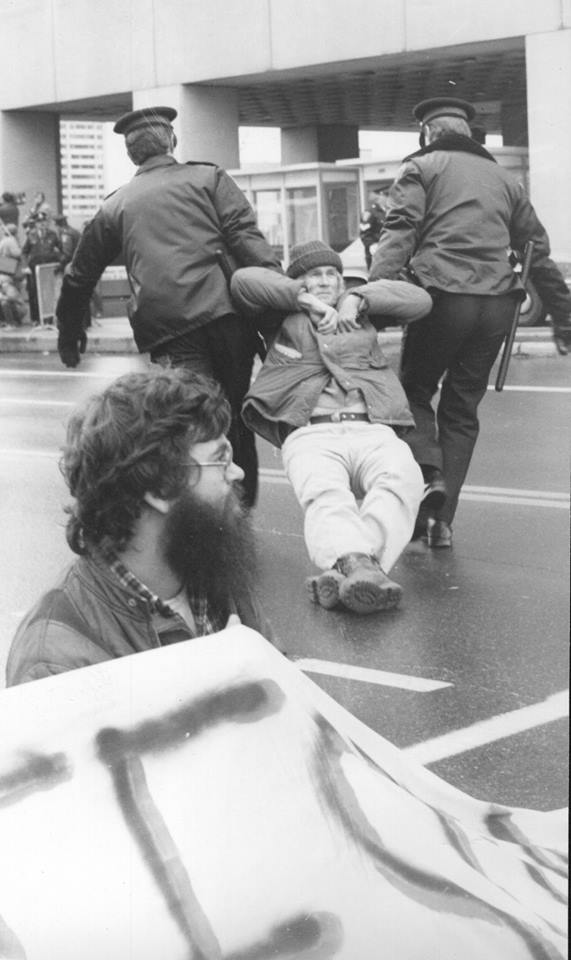 Alliance for Nonviolent Action
(ANVA) Alliance for Nonviolent Action
(ANVA)
Between 1984 and 1989, Roy and Sylvia were active with their son Richard in ANVA.
All three, for example, took part in a civil disobedience campaign in which they
joined 56 other activists from across
Ontario and Quebec to block traffic outside the main entrance to
Canada's Department of War. (See picture at left). This took place on
November 12, 1987, the day after Remembrance Day. When arrested, both Roy
and Sylvia were wearing their military medals. (Before Dunkirk, Sylvia had
served in the British Army's Auxiliary Territorial Service in the Orderly Room
of a Machine Gun Training Room. She then served as a clerk in Army's War Office
Records. Read about Roy's
two years of service as a RADAR technician in India.)
During the ANVA action,
seen at left, when Roy and Sylvia were seated blocking traffic, a policeman snapped
at Richard saying something like "It's because of veterans like them that you
can even be here to protest!" "That's right," I replied, "they're my parents." This action drew
attention to NATO pilot training and low-level warplane test flights over Nitassinan, the still unceded Innu land in so-called Labrador and Quebec.
Indigenous people there were being arrested for nonviolent, civil disobedience actions that
blocked military runways. Although Roy was only arrested this once, he also
helped with the planning and logistics for many other ANVA actions in Ottawa
throughout the late-1980s. Roy also played important support roles for Sylvia when she was arrested at
two
other ANVA actions. Those "sit downs" were to "Say a Real No to Star Wars"
(Nov. 1985) and to block entrances to the
ARMX weapons bazaar (May 1989). Roy recalled that when
Richard and Sylvia were arrested at External Affair during the 1985 action, the police dragged Sylvia
to the side of the street and left her there. She then got up and walked
back to rejoin the blockade! She did not give up easily. In 1989, when ANVA brought
well-known antiwar resister
Phil Berrigan to
speak in Ottawa, he stayed with Sylvia and Roy at their home.
"Adventure Peace
Tour" to the USSR
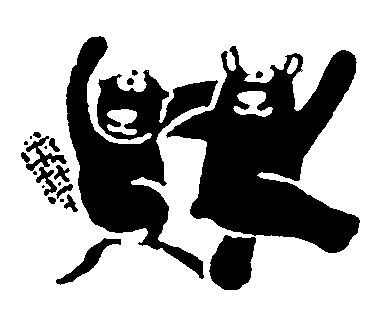 In 1985, Roy, Sylvia and Richard took part in
a
three-week trip to the
USSR. In the months
leading up to this tour, they took part is a
series of public events called "Living
Room Discussions on East-West Relations." These were organised in preparation for
the trip. These discussions and the trip itself were organised and led by
Koozma Tarasoff, a
Doukhobour-Canadian writer, photographer and peace activist who was then
president of the Ottawa chapter of the Canada-USSR Association. The 35
Canadian participants in this trip visited about ten cities in what are now four
countries: Russia, Azerbaijan, Georgia and Uzbekistan. There they visited many
sites of interest, like museums and galleries, historical sites and the mass
graves of millions of Sviet citizens who died in the fighting against Nazism.
Tour participants also
met with activists from Soviet peace, womens' and veterans' organisations.
Thanks to the rabid, mainstream paranoia that characterised the social phobias
of the Cold War, CJOH TV aired a libellous news
story about peace activists involved in the tour. Roy and Sylvia were instrumental in trying to obtain a
retraction and apology from the station. They found
a lawyer who represented the group pro bono in a legal case. Roy wrote letters
about the issue to various politicians and media authorities. Learn
more about the "Peace
Tour" itself in the
"Travels with Roy and Sylvia"
section, and about
their efforts to oppose CJOH's
defamatory "fake
news" story. In 1985, Roy, Sylvia and Richard took part in
a
three-week trip to the
USSR. In the months
leading up to this tour, they took part is a
series of public events called "Living
Room Discussions on East-West Relations." These were organised in preparation for
the trip. These discussions and the trip itself were organised and led by
Koozma Tarasoff, a
Doukhobour-Canadian writer, photographer and peace activist who was then
president of the Ottawa chapter of the Canada-USSR Association. The 35
Canadian participants in this trip visited about ten cities in what are now four
countries: Russia, Azerbaijan, Georgia and Uzbekistan. There they visited many
sites of interest, like museums and galleries, historical sites and the mass
graves of millions of Sviet citizens who died in the fighting against Nazism.
Tour participants also
met with activists from Soviet peace, womens' and veterans' organisations.
Thanks to the rabid, mainstream paranoia that characterised the social phobias
of the Cold War, CJOH TV aired a libellous news
story about peace activists involved in the tour. Roy and Sylvia were instrumental in trying to obtain a
retraction and apology from the station. They found
a lawyer who represented the group pro bono in a legal case. Roy wrote letters
about the issue to various politicians and media authorities. Learn
more about the "Peace
Tour" itself in the
"Travels with Roy and Sylvia"
section, and about
their efforts to oppose CJOH's
defamatory "fake
news" story.
 The
Summit Response Coalition The
Summit Response Coalition
In 1987, when President Reagan came to Canada
for the "Irish Eyes" summit meeting with Prime Minister Mulroney, Ottawa
activists came together to educate the public about a wide variety of issues
from peace and the environment, to Free Trade. On April 5, 1987, a mass
demonstration was held on Parliament Hill with many thousands of supporters.
Richard represented COAT on the Steering Committee of the Summit Response
Coalition which organised the protest and other activities. Roy and Sylvia
were also involved, of course. On April 4, Roy's image made it onto the
front page of the Ottawa Citizen. (Read
the article here.) The newspaper however was improperly informed and
mistakenly recorded Roy's name as Ken Hancock, an activist with ANVA. The
photo shows Roy with two latex political puppets created by son Richard.
Roy was holding the Ronald Reagan puppet, while Brian Mulroney puppet was held
by Richard, although the photo cropped him out. (Roy contributed to the
mechanics of the puppets by inventing an ingenious system -- using table tennis
balls -- so puppeteers could move the eyes back and forth.) Richard performed a
ten-minute show using recorded voices and a musical sound track to animate these
puppets. There was an uproarious response at the huge rally on Parliament
Hill. As a result, photos and descriptions of the puppet show found their
way into about 20 major newspapers across Canada and the US.
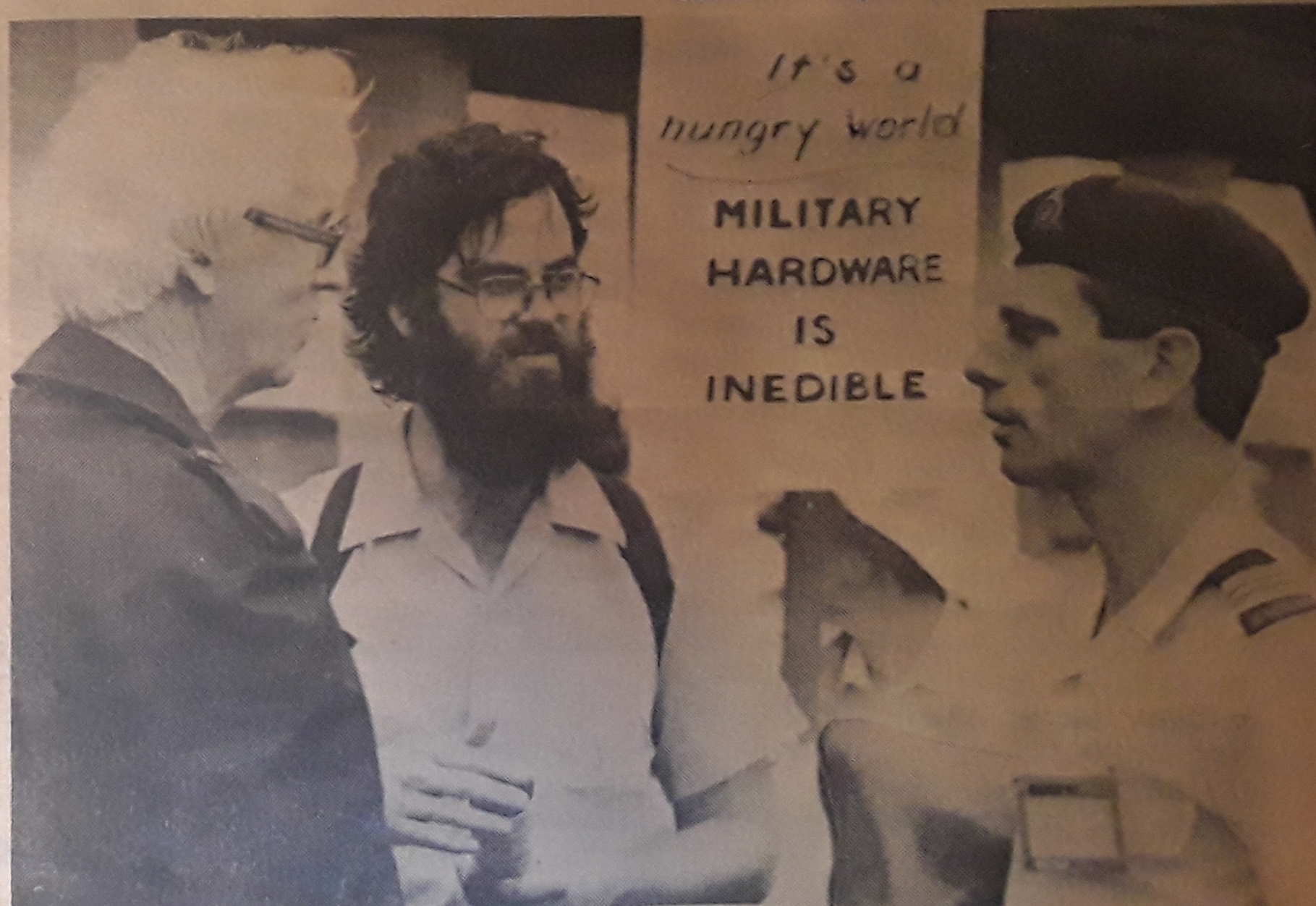 Demonstrating
against ARMX '87 Demonstrating
against ARMX '87
Roy took part in protesting the first appearance of ARMX in Ottawa in June 1987.
The photo at right shows Roy and Richard engaged in a quiet discussion with a
military participant who stopped to talk. He was interested to know that
Roy was a veteran and listened intently to Roy's opposition to to ARMX.
The protest was held outside the main entrance to Ottawa's Lansdowne Park, where
Canada's largest military trade show was being held.
In 1983 and 1985, this biennial government-run
weapons exhibition had been held at a military base in Quebec. When it was
privatised, they moved the show to City-owned, public property Ottawa.
Richard learned, from a fellow ANVA activist in Montreal, that ARMX was coming
to "The Glebe," a quiet downtown residential neighbourhood in Ottawa. In
response, Richard used his press credentials to arrange to attend the ARMX trade
show and interview its main organiser, Wolfgang Schmidt. This was aired on
the "Voice for Peace" radio program which Richard produced and hosted from 1985
until the late 1990s. The show was on CKCU FM, a community radio station
based at Carleton University. Richard also alerted activists who came
together for a protest that attracted about 50 people. The key organiser
of this protest was Ottawa Quaker Murray Thomson, a long time Sanders friend,
peace activist, and later, Roy's tennis partner. Murray drew on his connections
in the pacifist churches to draw about 50 people to the protest. The photo
above, by Doukhobour Koozma
Tarasoff, appeared with a front page article in the Mennonite Reporter
on June 22, 1987. (See the
article here.)
Coalition to Oppose the Arms Trade (COAT)
COAT
COAT was brought together to expose and oppose the 1989 return to Ottawa of ARMX, Canada's largest international
arms bazaar. Sylvia and Roy were driving forces within COAT from its formation
by their son Richard in late 1988. The three were central to organising COAT's first protest
march which rallied three or four thousand people to the gates of ARMX in May
1989. (That first campaign led to Ottawa City Council's 20-year ban on
hosting arms trade shows on municipal property.) For many years, Roy was COAT's
recording secretary and took the minutes at its monthly meetings. Together
Roy and Sylvia worked with COAT to promote conversion, oppose the weapons trade
and to protest Canadian complicity in various US/NATO-led wars. They were
also very involved in COAT's successful campaign to stop the Department of National Defence from demolishing a heritage building on Rideau Street
called Wallis House. Another COAT "conversion" campaign raised awareness about
violent games by establishing a roving "War Toys Recycling Depot." (See the
entry on CCND - Ottawa above.)
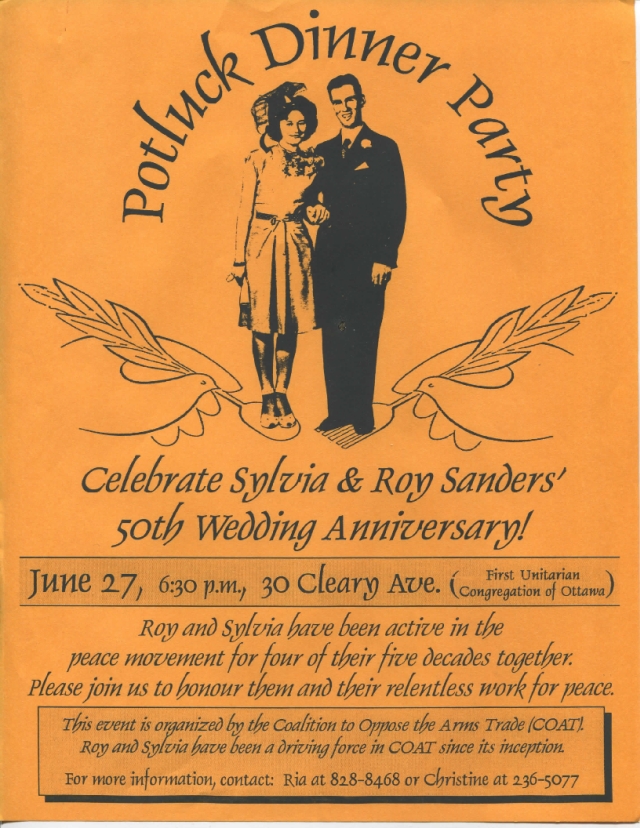 Besides organizing peace rallies,
marches, vigils, panel discussions, and conferences, Roy and Sylvia also helped COAT to
plan and organise large social events to build community within Ottawa's peace movement.
These events included large fundraising dinners at which special COAT supporters and activists
were "roasted." COAT's roastees included former mayor Marion Dewar,
"Labour Jim" MacDonald from the Canadian Labour Congress, and
well-known Quaker peace
activist Murray Thomson. Throughout the 1990s and early 2000s, Roy and
Sylvia were deeply engaged in making all these COAT events happen. But as well
as helping to make these events happen, Roy and Sylvia also did much
behind-the-scenes work on COAT's national campaigns and helped with its magazine, Press
for Conversion! (Sylvia solicited ads, while Roy masterminded the
complex procedure that was initially required by Canada Post to sort our big
mailings.) In 1996, to honour their special role in the organisation, COAT
organised a large
"Potluck Dinner Party" to celebrate their 50th wedding anniversary. (Click
here for more information about that event.) Roy and Sylvia
remained central to COAT's work until 2002 when Sylvia suffered a stroke and
Roy became her primary care giver at home.
It was the end of an era for COAT, and for the peace movement in general. (Read
a newspaper article, "A
Family that Protests Together..." about the peace activism of Roy, Sylvia
and Richard.) Besides organizing peace rallies,
marches, vigils, panel discussions, and conferences, Roy and Sylvia also helped COAT to
plan and organise large social events to build community within Ottawa's peace movement.
These events included large fundraising dinners at which special COAT supporters and activists
were "roasted." COAT's roastees included former mayor Marion Dewar,
"Labour Jim" MacDonald from the Canadian Labour Congress, and
well-known Quaker peace
activist Murray Thomson. Throughout the 1990s and early 2000s, Roy and
Sylvia were deeply engaged in making all these COAT events happen. But as well
as helping to make these events happen, Roy and Sylvia also did much
behind-the-scenes work on COAT's national campaigns and helped with its magazine, Press
for Conversion! (Sylvia solicited ads, while Roy masterminded the
complex procedure that was initially required by Canada Post to sort our big
mailings.) In 1996, to honour their special role in the organisation, COAT
organised a large
"Potluck Dinner Party" to celebrate their 50th wedding anniversary. (Click
here for more information about that event.) Roy and Sylvia
remained central to COAT's work until 2002 when Sylvia suffered a stroke and
Roy became her primary care giver at home.
It was the end of an era for COAT, and for the peace movement in general. (Read
a newspaper article, "A
Family that Protests Together..." about the peace activism of Roy, Sylvia
and Richard.)
 Unitarian Universalist Fellowship of Ottawa
(UUFO) Unitarian Universalist Fellowship of Ottawa
(UUFO)
Roy and Sylvia Sanders became founding members of the UUFO when it was
formed in 1996. Rev.
Fred Cappuccino (who spoke at Roy's memorial service) was instrumental to this process. Roy and Sylvia had
initially met Child Haven founders Fred and Bonnie Cappuccino through peace movement work in the
early 1990s. The Cappuccinos then joined with Roy, Sylvia, Richard, and others
on COAT's Steering Committee, to organise many large peace-related events.
Over the decades, other Unitarian activists/friends of Roy and Sylvia, within the
UUFO and the First
Unitarian Congregation, were also involved in COAT's work. Roy's 90th birthday party
(2014) and his memorial service (2018), were both held at the UUFO's meeting
place on McArthur Road, and were attended by many Unitarians.
 Even
into his final years,
Roy remained committed to standing up for the peace issues, even
if he had to use his walker! In what was to be his final public stance on
peace issues, Roy made a statement at an official government-sponsored event in
2015. His statement at that event summed up some of the peace issues that
had motivated his activism for many decades. This final public statement came
when the government was celebrating the 50th anniversary of Canada's maple-leaf
flag. The ceremony was held at the National Research Council (NRC)
where Roy had worked for almost 30
years (1950-1979). The event's purpose was to commemorate NRC's work
to stabilize and
define the exact colour for Canada's new flag
in 1965. (The photo at left shows NRC friends, colleagues and fellow retirees:
Ron Burton, Roy Sanders and
Clarence Dodd.) Even
into his final years,
Roy remained committed to standing up for the peace issues, even
if he had to use his walker! In what was to be his final public stance on
peace issues, Roy made a statement at an official government-sponsored event in
2015. His statement at that event summed up some of the peace issues that
had motivated his activism for many decades. This final public statement came
when the government was celebrating the 50th anniversary of Canada's maple-leaf
flag. The ceremony was held at the National Research Council (NRC)
where Roy had worked for almost 30
years (1950-1979). The event's purpose was to commemorate NRC's work
to stabilize and
define the exact colour for Canada's new flag
in 1965. (The photo at left shows NRC friends, colleagues and fellow retirees:
Ron Burton, Roy Sanders and
Clarence Dodd.)
At this ceremony, after being honoured for his part in that
scientific process, Roy was asked to say a few words. One of Roy's
NRC colleagues, Alan
Robertson, recalled this memory at Roy's "Celebration of Life"
Service:
"After
receiving a plaque commemorating the work, Roy was photographed in front
of the flag and asked about his feelings. His main comment in response was
that he hoped that the flag would never be used to march behind into war."
This was classic Roy. With a few quiet words
he captured his opposition to blindly following a symbol of nationalism into the
horrors of militarism and war.
Roy will always be remembered as a gentle, quiet,
humble and soft-spoken man, who was reticent and nervous about public speaking.
But, while always reluctant to voice his opposition to war and injustice in an
outspoken public way, he was willing to stand up (or even sit down) for the
peace issues in which he so strongly believed. He was also a prolific
letter writer who was ready to confront politicians at all levels on a diverse
array of peace-related subjects. For decades he lent his support to the
peace movement and often worked hard behind the scenes to help plan and carry
out large events and campaigns. While generally avoiding the spotlight, he
focused his efforts on doing many much-needed, practical, logistical tasks for
peace. However, if needed, he was not afraid to express his beliefs, even
if they ran counter to the official mainstream narrative.
His support, commitment and dedication to the peace
movement over many decades are sorely missed but he will not be forgotten.
Have something to add?
If you have any further information or
photos that you could share regarding Roy six decades of involvement in
peace-related efforts, please let me know.
Many thanks!
Richard Sanders <overcoat@rogers.com> |
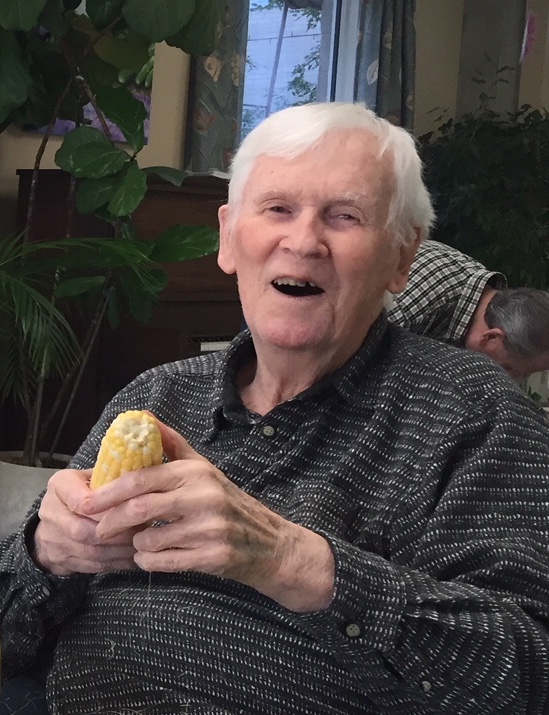









 Sylvia was on the Congregation's
Board of Directors in 1967 when the Church decided to move to their current location on Cleary Avenue in Ottawa's west end. Along with
friend and fellow peace and civil rights activist, Nick Aplin, Roy was elected to the
congregation's Board in 1970.
Roy and Sylvia's involvement with the congregation often involved trying to move its
members and ministers to become more actively involved in protesting war and
promoting peace issues. This was especially difficult at times, such as during
the Vietnam War, when a Minister of the Church, an American, had great difficulty
bringing himself to criticise the US government. (
Sylvia was on the Congregation's
Board of Directors in 1967 when the Church decided to move to their current location on Cleary Avenue in Ottawa's west end. Along with
friend and fellow peace and civil rights activist, Nick Aplin, Roy was elected to the
congregation's Board in 1970.
Roy and Sylvia's involvement with the congregation often involved trying to move its
members and ministers to become more actively involved in protesting war and
promoting peace issues. This was especially difficult at times, such as during
the Vietnam War, when a Minister of the Church, an American, had great difficulty
bringing himself to criticise the US government. ( Roy and Sylvia began attending protests and marches held by the CARH in 1959.
The organisation was active in raising much-needed public awareness about the hazards of
nuclear fallout that were being caused by the atmospheric testing of atomic bombs.
In 1957, when Richard was born, the US exploded 34 nuclear bombs yielding 346
kilotons. In the following year they blew up 75 more nuclear bombs. Those
bombs, in 1958 alone, exploded with an energy equivalent to 35,700 kilotons of
TNT. The destruction of Hiroshima used a bomb yielding only 15 kilotons, while
Nagasaki was 20 kilotons. All of the radioactive material from the US nuclear
"testing" program went into the atmosphere and then fell to earth. Since many of
most of these explosions were done in Nevada, and the prevailing winds were
blowing all that radioactive fallout eastward, there were obvious and very
legitimate concerns about environmental damage and negative impacts on people's
health. However, only a small number of people cared or even knew anything
about what was going on. Many still don't even know that the US exploded
so many nuclear bombs within its own borders. (See this list of 29 nuclear
explosions that were part of
Roy and Sylvia began attending protests and marches held by the CARH in 1959.
The organisation was active in raising much-needed public awareness about the hazards of
nuclear fallout that were being caused by the atmospheric testing of atomic bombs.
In 1957, when Richard was born, the US exploded 34 nuclear bombs yielding 346
kilotons. In the following year they blew up 75 more nuclear bombs. Those
bombs, in 1958 alone, exploded with an energy equivalent to 35,700 kilotons of
TNT. The destruction of Hiroshima used a bomb yielding only 15 kilotons, while
Nagasaki was 20 kilotons. All of the radioactive material from the US nuclear
"testing" program went into the atmosphere and then fell to earth. Since many of
most of these explosions were done in Nevada, and the prevailing winds were
blowing all that radioactive fallout eastward, there were obvious and very
legitimate concerns about environmental damage and negative impacts on people's
health. However, only a small number of people cared or even knew anything
about what was going on. Many still don't even know that the US exploded
so many nuclear bombs within its own borders. (See this list of 29 nuclear
explosions that were part of
 Canadian
Canadian


 In the
mid-1960s, Sylvia and Roy were active in Ottawa-based solidarity work to support civil rights
activists who were on the front line in nonviolent struggles against the
brutal apartheid system in the U.S. For example, between 1964 and 1966,
Sylvia was deeply involved in helping to bring the
In the
mid-1960s, Sylvia and Roy were active in Ottawa-based solidarity work to support civil rights
activists who were on the front line in nonviolent struggles against the
brutal apartheid system in the U.S. For example, between 1964 and 1966,
Sylvia was deeply involved in helping to bring the 
 More
than a year later, Sylvia was still was at the centre of these controversial
fundraising efforts. This time Ottawa peace activists were holding a "tag day."
On May 24, 1968, the Ottawa Citizen reported that organisers had 100
volunteers to collect money at 16 Ottawa shopping centres. To announce their
fundraising campaign the Committee took out an ad in the Citizen. (See
image, right). This ad included a list of
about 250 "local citizens" who had "lent their names as public sponsors" of
the appeal. (
More
than a year later, Sylvia was still was at the centre of these controversial
fundraising efforts. This time Ottawa peace activists were holding a "tag day."
On May 24, 1968, the Ottawa Citizen reported that organisers had 100
volunteers to collect money at 16 Ottawa shopping centres. To announce their
fundraising campaign the Committee took out an ad in the Citizen. (See
image, right). This ad included a list of
about 250 "local citizens" who had "lent their names as public sponsors" of
the appeal. ( AntiApartheid Protests
AntiApartheid Protests Ottawa Committee for
Ottawa Committee for
 nuclear
disarmament. They collected names on a petition to pressure the Gloucester City
Council to have a referendum on nuclear disarmament during the November 1982
municipal elections. For this purpose they attended three Gloucester Council
meetings. (In this 1982 photo, Roy wears a toque and light coat, centre left,
while Sylvia holds banner which she made, at right. That's Dorothy Funke in the
Centre.)
nuclear
disarmament. They collected names on a petition to pressure the Gloucester City
Council to have a referendum on nuclear disarmament during the November 1982
municipal elections. For this purpose they attended three Gloucester Council
meetings. (In this 1982 photo, Roy wears a toque and light coat, centre left,
while Sylvia holds banner which she made, at right. That's Dorothy Funke in the
Centre.) Alliance for Nonviolent Action
(ANVA)
Alliance for Nonviolent Action
(ANVA) In 1985, Roy, Sylvia and Richard took part in
a
In 1985, Roy, Sylvia and Richard took part in
a
 The
Summit Response Coalition
The
Summit Response Coalition Demonstrating
against ARMX '87
Demonstrating
against ARMX '87 Besides organizing peace rallies,
Besides organizing peace rallies, 
 Even
into his final years,
Even
into his final years,